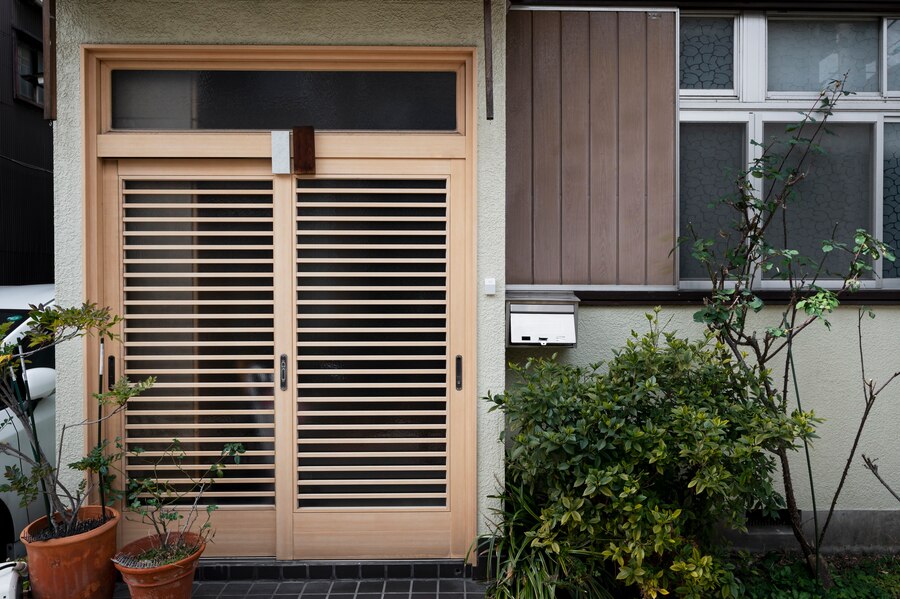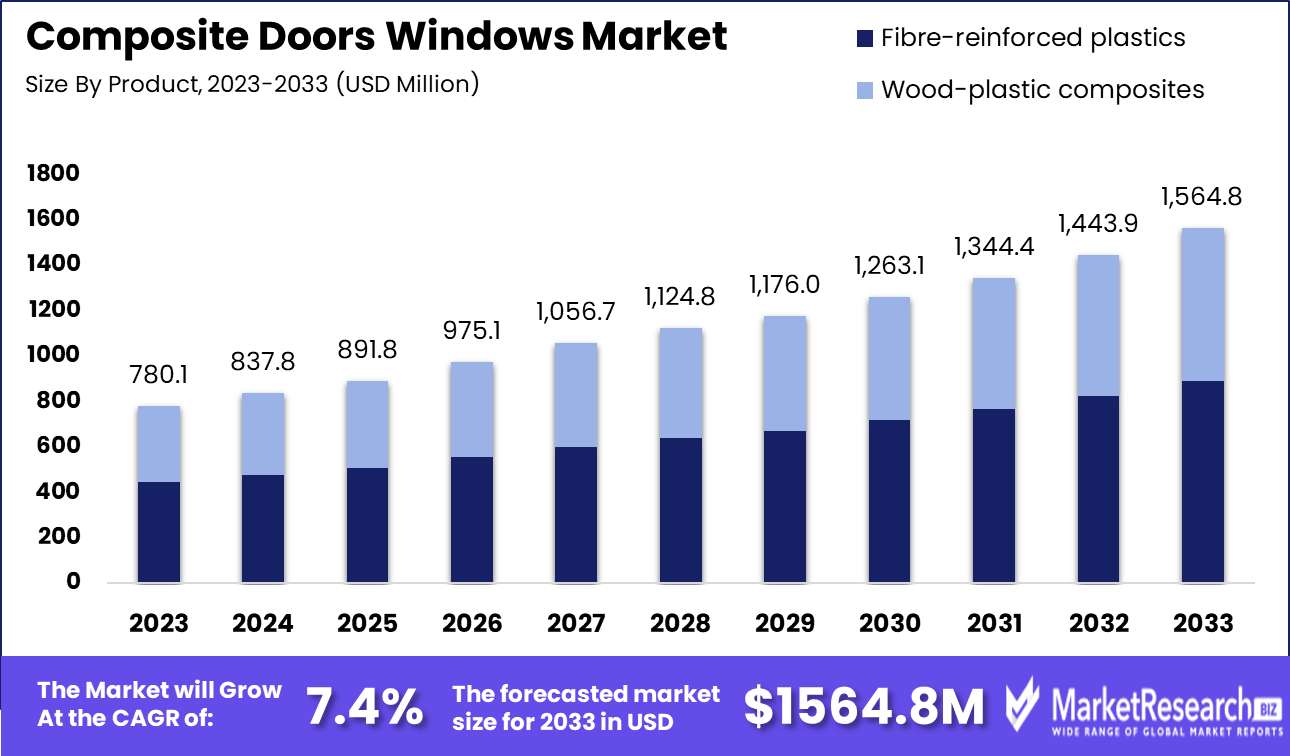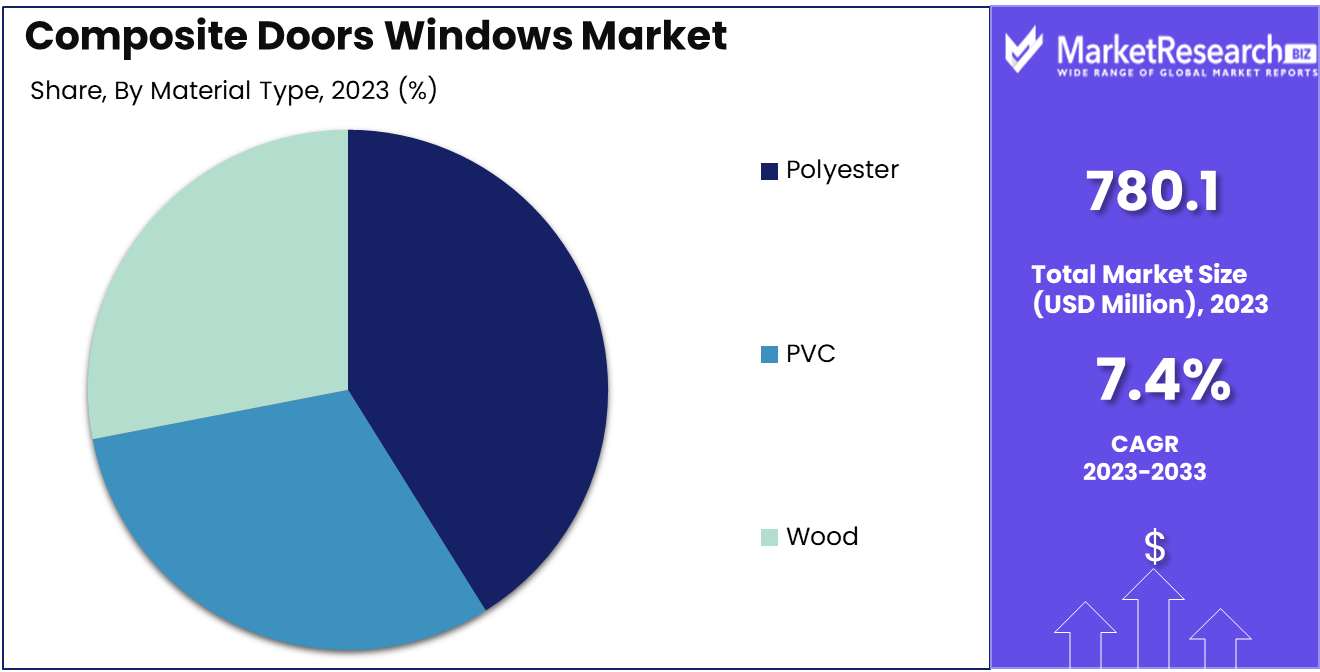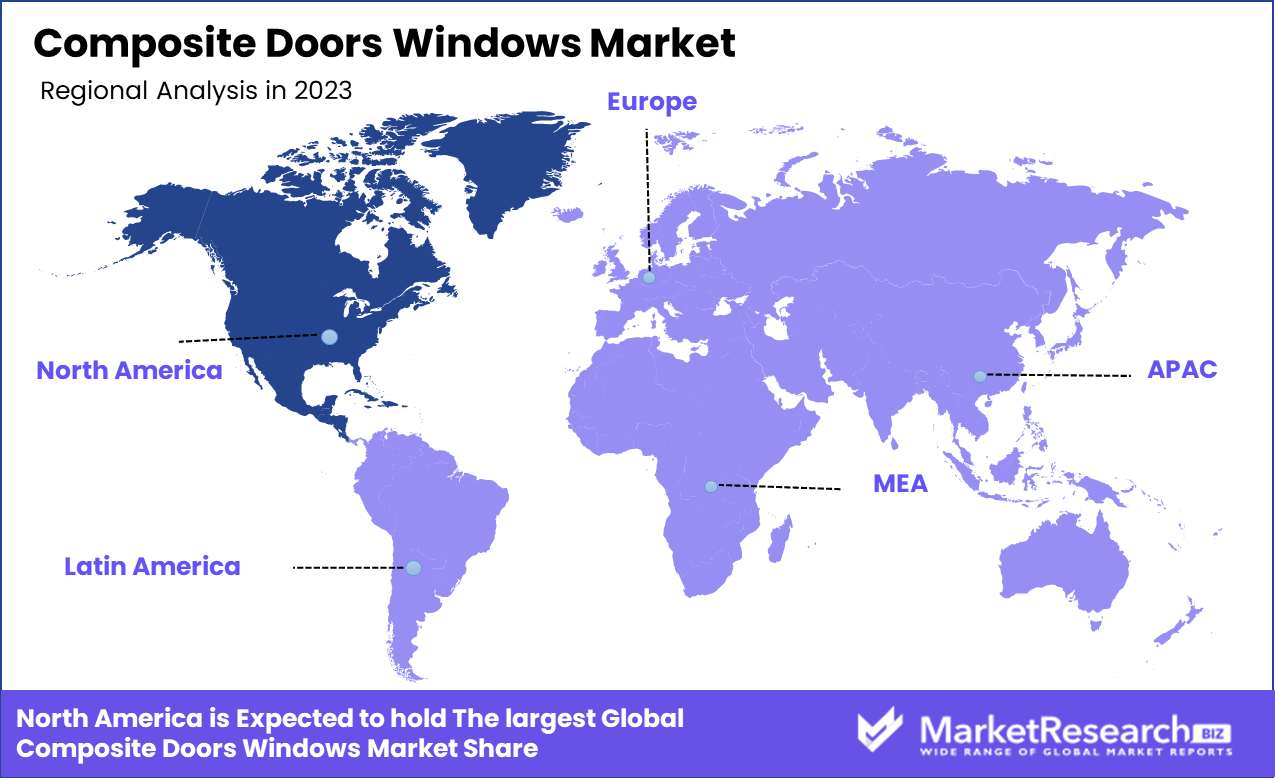
Composite Doors Windows Market By Product (Fibre-reinforced plastics, Wood-plastic composites), By Material Type (Polyester, PVC, Wood), By Application (Industrial, Commercial, Residential), By Region And Companies - Industry Segment Outlook, Market Assessment, Competition Scenario, Trends, And Forecast 2024-2033
-
50586
-
August 2024
-
300
-
-
This report was compiled by Shreyas Rokade Shreyas Rokade is a seasoned Research Analyst with CMFE, bringing extensive expertise in market research and consulting, with a strong background in Chemical Engineering. Correspondence Team Lead-CMFE Linkedin | Detailed Market research Methodology Our methodology involves a mix of primary research, including interviews with leading mental health experts, and secondary research from reputable medical journals and databases. View Detailed Methodology Page
-
Quick Navigation
Report Overview
The Composite Doors Windows Market was valued at USD 780.1 million in 2023. It is expected to reach USD 1564.8 million by 2033, with a CAGR of 7.4% during the forecast period from 2024 to 2033.
The Composite Doors and Windows Market refers to the industry encompassing the production and distribution of doors and windows made from composite materials, combining elements such as wood, PVC, and fiberglass to enhance durability, thermal efficiency, and aesthetic appeal. These products offer superior resistance to weather, corrosion, and wear, making them increasingly popular in residential, commercial, and industrial applications.

The composite doors and windows market is experiencing significant growth, driven by the increasing demand for durable, low-maintenance solutions in residential and commercial constructions. Composite materials, known for their exceptional strength and resistance to weathering, are becoming the preferred choice over traditional wood or metal counterparts. The market is further bolstered by the energy efficiency that composite doors and windows offer, which is increasingly critical as global energy regulations tighten and consumer awareness of energy conservation rises. These products provide superior insulation, reducing energy costs and making them highly appealing to eco-conscious consumers and builders alike.
However, the market faces challenges due to the high initial costs associated with composite doors and windows, which may limit adoption among cost-sensitive segments. Despite this, technological advancements are helping to mitigate these costs by improving production efficiency and enabling the development of more affordable options. Innovations in design and materials are also expanding the application range of composite doors and windows, making them suitable for various architectural styles and climate conditions. As the market continues to evolve, these advancements are expected to drive further growth, solidifying the position of composite materials as a cornerstone in modern construction.
Key Takeaways
- Market Growth: The Composite Doors Windows Market was valued at USD 780.1 million in 2023. It is expected to reach USD 1564.8 million by 2033, with a CAGR of 7.4% during the forecast period from 2024 to 2033.
- By Product: Fibre-reinforced plastics (FRPs) dominated the Composite Doors and Windows Market
- By Material Type: Polyester dominated due to durability and versatility in composites.
- By Application: The Industrial segment dominated the Composite Doors and Windows Market.
- Regional Dominance: North America dominates the Composite Doors and Windows Market with a 35% share.
- Growth Opportunity: The Composite Doors and Windows Market will experience robust growth, fueled by rising consumer awareness and diversified product offerings that cater to evolving preferences and technological advancements.
Driving factors
Sustainability and Eco-Friendliness: Driving Demand for Environmentally Responsible Building Materials
The growing emphasis on sustainability and eco-friendliness is a primary driver of the Composite Doors and Windows Market. As global awareness of environmental issues increases, consumers and builders are seeking materials that reduce carbon footprints and minimize environmental impact. Composite doors and windows, often made from recycled or sustainable materials, offer superior energy efficiency, reducing the need for additional heating or cooling in buildings. This eco-friendly attribute aligns with the increasing regulatory pressures and consumer preferences for green buildings. According to recent industry reports, the demand for green building materials is expected to grow at a CAGR of 11.6% from 2023 to 2030, further propelling the composite doors and windows market.
Technological Advancements: Enhancing Performance and Expanding Market Reach
Technological advancements in the manufacturing of composite materials have significantly contributed to the growth of the Composite Doors and Windows Market. Innovations in material science have led to the development of composite products that offer enhanced durability, thermal insulation, and resistance to harsh weather conditions. These advancements not only improve the lifespan and performance of doors and windows but also reduce maintenance costs, making them an attractive option for both residential and commercial applications.
Furthermore, advancements in manufacturing processes, such as automation and precision engineering, have enabled mass production at lower costs, broadening the market reach. As a result, the market for composite doors and windows is projected to grow at a steady pace, with technological innovations playing a key role in meeting diverse consumer needs.
Aesthetic Versatility: Catering to Diverse Consumer Preferences and Architectural Trends
The aesthetic versatility of composite doors and windows is another crucial factor driving market growth. These products can be designed to mimic the appearance of traditional materials such as wood or metal, while offering superior performance and lower maintenance requirements. The ability to customize colors, textures, and finishes allows architects and homeowners to achieve specific design aesthetics without compromising on durability or energy efficiency. This flexibility in design has made composite doors and windows a preferred choice in modern architecture, where the integration of form and function is paramount. With the increasing trend towards personalized and unique home designs, the demand for aesthetically versatile composite products is expected to rise, contributing significantly to market expansion.
Restraining Factors
Rising Demand for Energy Efficiency Driving Adoption of Composite Doors and Windows
The growing global emphasis on energy efficiency has significantly influenced the adoption of composite doors and windows. As building regulations become more stringent regarding thermal performance and energy conservation, consumers and businesses are increasingly turning to composite materials that offer superior insulation properties. Composite doors and windows, typically made from a combination of materials such as wood, PVC, and aluminum, provide excellent thermal insulation, which reduces heat loss and improves energy efficiency in buildings.
According to recent studies, energy-efficient building components, including composite doors and windows, can lower energy consumption by up to 30%, making them an attractive choice for both residential and commercial constructions. This rising demand for energy-efficient solutions is expected to drive substantial growth in the composite doors and windows market.
Sustainable Building Practices Propelling Growth in Composite Doors and Windows Market
Sustainable building practices are increasingly being adopted across the globe, driven by both regulatory pressures and consumer demand for environmentally friendly products. Composite doors and windows align well with these practices as they are often made from recycled or sustainable materials and have a longer lifespan compared to traditional wooden or metal alternatives. This not only reduces the environmental impact associated with frequent replacements but also minimizes waste.
Moreover, composite materials can be designed to enhance the sustainability of buildings by improving energy efficiency and reducing the carbon footprint. The global green building materials market is projected to grow at a CAGR of 11.6% from 2023 to 2028, and the adoption of composite doors and windows is expected to be a significant contributor to this trend. As the construction industry continues to prioritize sustainability, the composite doors and windows market is poised for robust growth.
By Product Analysis
Fiber-reinforced plastics (FRPs) dominated the Composite Doors and Windows Market in 2023.
In 2023, Fibre-reinforced plastics (FRPs) held a dominant market position in the by-product segment of the Composite Doors and Windows Market. The superior strength-to-weight ratio, durability, and resistance to environmental factors such as moisture and corrosion make FRPs highly preferred in construction applications. These materials offer enhanced thermal insulation and acoustic properties, contributing to their widespread adoption in residential and commercial buildings. Additionally, the rising demand for energy-efficient solutions and the growing trend of sustainable construction have further fueled the demand for FRP-based doors and windows.
Meanwhile, Wood-plastic composites (WPCs) also gained significant traction in the market, owing to their aesthetic appeal and lower maintenance requirements. WPCs offer the look and feel of natural wood while providing superior resistance to rot, warping, and pests, making them a popular choice for exterior applications. The increasing consumer preference for eco-friendly materials, coupled with advancements in manufacturing technologies, has bolstered the adoption of WPCs in the composite doors and windows segment. Both FRPs and WPCs are expected to continue driving growth in this market, supported by innovations and evolving consumer preferences.
By Material Type Analysis
In 2023, Polyester dominated due to its durability and versatility in composites.
In 2023, Polyester held a dominant market position in the By Material Type segment of the Composite Doors and Windows Market, driven by its superior durability and versatility. Polyester's resistance to harsh environmental conditions and its ability to maintain structural integrity under stress have made it the material of choice for both residential and commercial applications. Its ease of customization and aesthetic appeal further contributed to its widespread adoption, making it a preferred material in the construction of composite doors and windows.
PVC also demonstrated significant market share in 2023, owing to its cost-effectiveness and excellent thermal insulation properties. The material’s lightweight nature, combined with its ability to offer effective noise reduction, has made it increasingly popular in urban areas where energy efficiency and soundproofing are critical considerations.
Wood, while traditionally favored for its natural aesthetic and strength, accounted for a smaller share in the composite doors and windows market. However, it continued to appeal to niche markets that prioritize sustainability and a classic appearance, especially in high-end residential constructions where premium materials are preferred.

By Application Analysis
In 2023, The Industrial segment dominated the Composite Doors and Windows Market.
In 2023, The Industrial segment held a dominant market position in the Composite Doors and Windows Market, particularly within the "By Application" category. The Industrial segment's dominance can be attributed to the increasing demand for durable and energy-efficient materials in industrial facilities. Composite doors and windows, known for their superior thermal insulation, corrosion resistance, and minimal maintenance requirements, have become the preferred choice for industrial applications, particularly in manufacturing plants, warehouses, and other large-scale industrial establishments. This segment benefits from the rising investments in infrastructure projects and the growing emphasis on energy efficiency and sustainability in industrial operations.
The Commercial segment also experienced significant growth in 2023, driven by the construction of commercial buildings, such as offices, retail spaces, and hotels. Composite doors and windows are favored in this segment for their aesthetic appeal, security features, and long lifespan, which align with the needs of commercial properties.
The Residential segment, while growing, remains a smaller share of the market. Homeowners are increasingly opting for composite materials due to their durability and environmental benefits, but adoption is slower compared to industrial and commercial applications.
Key Market Segments
By Product
- Fiber-reinforced plastics
- Wood-plastic composites
By Material Type
- Polyester
- PVC
- Wood
By Application
- Industrial
- Commercial
- Residential
Growth Opportunity
Expanding Market Potential Through Consumer Awareness
The global Composite Doors and Windows Market is poised for substantial growth, driven primarily by increasing consumer awareness. As consumers become more informed about the benefits of composite materials—such as enhanced durability, energy efficiency, and resistance to weathering—the demand for these products is expected to rise significantly. This growing awareness is not just limited to residential applications; commercial sectors are also recognizing the long-term cost savings and minimal maintenance requirements associated with composite doors and windows. As a result, companies that effectively educate their target audience about these advantages are likely to see increased market penetration and customer loyalty.
Diversifying Product Portfolios to Capture New Markets
The expansion of product offerings presents another key opportunity for growth in the Composite Doors and Windows Market. Manufacturers are increasingly diversifying their product lines to include a variety of styles, colors, and finishes, catering to a broader spectrum of consumer preferences. This strategic expansion is particularly relevant in regions where traditional materials like wood and metal have dominated. By offering composite alternatives that mimic the aesthetic appeal of these traditional materials while providing superior performance, companies can tap into new customer segments. Additionally, the integration of smart technologies into composite doors and windows is emerging as a trend, offering enhanced security and convenience features that appeal to tech-savvy consumers.
Latest Trends
Rising Demand for Sustainability
The market for composite doors and windows is expected to witness a significant shift towards sustainable products. Consumers and builders are increasingly prioritizing eco-friendly materials that reduce environmental impact. Composite doors and windows, which are often made from a blend of recycled wood, PVC, and other materials, meet this demand by offering durability, energy efficiency, and lower carbon footprints compared to traditional materials like wood or aluminum. Manufacturers are likely to invest in green certifications and innovations to enhance the sustainability of their products, aligning with global sustainability goals and attracting environmentally conscious consumers.
Increased DIY Trends
The DIY (Do-It-Yourself) trend is also anticipated to drive growth in the composite doors and windows market. Homeowners are becoming more involved in renovation projects, seeking easy-to-install products that offer customization options. Composite doors and windows, known for their ease of installation and low maintenance, are well-positioned to capitalize on this trend. The rise of online tutorials and e-commerce platforms further supports this shift, enabling consumers to purchase and install these products independently. As a result, companies are expected to focus on developing user-friendly products and offering comprehensive guides to cater to the growing DIY market segment.
Regional Analysis
North America dominates the Composite Doors and Windows Market with a 35% share.
The Composite Doors and Windows Market exhibits diverse growth patterns across various regions, driven by varying construction activities, consumer preferences, and regulatory standards. In North America, the market is witnessing significant growth, primarily due to the increasing demand for energy-efficient and sustainable building materials. The region holds a dominant position, accounting for approximately 35% of the global market share, propelled by stringent building codes and a strong emphasis on reducing energy consumption in residential and commercial constructions.
Europe follows closely, driven by the rising trend of green buildings and the implementation of energy performance regulations. The market in this region benefits from the growing adoption of composite materials for their superior insulation properties and durability, with a notable presence in countries like Germany, the UK, and France.
In the Asia Pacific, rapid urbanization, coupled with increasing construction activities in emerging economies like China and India, fuels the market's expansion. The region is expected to witness the highest growth rate, supported by government initiatives to promote energy-efficient infrastructure.
The Middle East & Africa region experiences moderate growth, with increasing investments in infrastructure projects and the rising adoption of composite doors and windows in commercial buildings. However, the market is constrained by lower awareness and higher costs compared to traditional materials.
Latin America shows steady growth, driven by the construction sector's gradual recovery and increasing awareness of the benefits of composite materials. However, economic instability in some countries poses challenges to the market's full potential in the region. Overall, North America remains the most influential region in the global composite doors and windows market, leading in both market size and technological advancements.

Key Regions and Countries
North America
- The US
- Canada
- Rest of North America
Europe
- Germany
- France
- The UK
- Spain
- Netherlands
- Russia
- Italy
- Rest of Europe
Asia-Pacific
- China
- Japan
- Singapore
- Thailand
- South Korea
- Vietnam
- India
- New Zealand
- Rest of Asia Pacific
Latin America
- Mexico
- Brazil
- Rest of Latin America
Middle East & Africa
- Saudi Arabia
- South Africa
- UAE
- Rest of the Middle East & Africa
Key Players Analysis
The global composite doors and windows market is poised for robust growth, with key players driving innovation and market penetration. Companies like Dortex and Special-Lite, Inc. are expected to continue their dominance by focusing on high-performance materials and expanding their product offerings to meet the increasing demand for energy-efficient and durable solutions. Assa Abloy Group and Curries are leveraging their extensive global distribution networks and investing heavily in R&D to stay ahead in the competitive landscape.
Andersen Corporation and Pella Corporation are likely to maintain their strong market positions by emphasizing sustainability and customization, catering to the growing trend of eco-friendly construction. These companies are also anticipated to benefit from the rising consumer preference for aesthetically pleasing and maintenance-free doors and windows.
In Europe, Vello Nordic AS and Fiberline Building Profiles are expected to capitalize on the region's stringent energy regulations by offering advanced composite solutions that enhance thermal efficiency. Fiber Tech Composite Pvt. Ltd. and Wood Plastic Composite Technologies are likely to see significant growth in emerging markets due to their cost-effective and innovative product lines.
Additionally, companies like Virtuoso and Nationwide Windows are set to make substantial gains by focusing on high-quality, bespoke composite products that meet the specific needs of residential and commercial projects. Overall, 2024 is expected to be a year of strategic collaborations, product innovations, and increased market competition among these key players, driving the global composite doors and windows market forward.
Market Key Players
- Dortex
- Special-Lite, Inc.
- Curries, Assa Abloy Group
- Vello Nordic AS
- Fiber Tech Composite Pvt. Ltd.
- Andersen Corporation
- Pella Corporation
- Wood Plastic Composite Technologies
- Hardy Smith Designs Private Limited
- Cascadia
- Just Doors UK Ltd.
- Fiberline Building Profiles
- Nationwide Windows
- Virtuoso
- Ecoste
- Worthing Windows
- Ravalsons
- Chem-Pruf
Recent Development
- In July 2024, TechDoors Innovations unveiled a breakthrough in composite door technology, introducing a lightweight yet highly durable composite material. This advancement is projected to reduce installation costs and enhance product performance, thereby influencing market dynamics and consumer preferences within the industry.
- In May 2024, EcoBuild Corporation completed the acquisition of GreenMaterials Inc., aiming to strengthen its position in the sustainable composite doors and windows segment. This strategic acquisition is expected to enhance EcoBuild's product portfolio with environmentally friendly materials and manufacturing processes.
- In March 2024, SecureHome Ltd. introduced a new line of smart composite windows integrated with advanced sensors and automation capabilities. These windows are designed to enhance energy efficiency and provide increased security features, responding to the growing consumer demand for intelligent home solutions.
Report Scope
Report Features Description Market Value (2023) USD 780.1 Million Forecast Revenue (2033) USD 1564.8 Million CAGR (2024-2032) 7.4% Base Year for Estimation 2023 Historic Period 2016-2023 Forecast Period 2024-2033 Report Coverage Revenue Forecast, Market Dynamics, COVID-19 Impact, Competitive Landscape, Recent Developments Segments Covered By Product (Fibre-reinforced plastics, Wood-plastic composites), By Material Type (Polyester, PVC, Wood), By Application (Industrial, Commercial, Residential) Regional Analysis North America - The US, Canada, Rest of North America, Europe - Germany, France, The UK, Spain, Italy, Russia, Netherlands, Rest of Europe, Asia-Pacific - China, Japan, South Korea, India, New Zealand, Singapore, Thailand, Vietnam, Rest of Asia Pacific, Latin America - Brazil, Mexico, Rest of Latin America, Middle East & Africa - South Africa, Saudi Arabia, UAE, Rest of Middle East & Africa Competitive Landscape Dortex, Special-Lite, Inc., Curries, Assa Abloy Group, Vello Nordic AS, Fiber Tech Composite Pvt. Ltd., Andersen Corporation, Pella Corporation, Wood Plastic Composite Technologies, Hardy Smith Designs Private Limited, Cascadia, Just Doors UK Ltd., Fiberline Building Profiles, Nationwide Windows, Virtuoso, Ecoste, Worthing Windows, Ravalsons, Chem-Pruf Customization Scope Customization for segments, region/country-level will be provided. Moreover, additional customization can be done based on the requirements. Purchase Options We have three licenses to opt for Single User License, Multi-User License (Up to 5 Users), Corporate Use License (Unlimited User and Printable PDF) -
-
- Dortex
- Special-Lite, Inc.
- Curries, Assa Abloy Group
- Vello Nordic AS
- Fiber Tech Composite Pvt. Ltd.
- Andersen Corporation
- Pella Corporation
- Wood Plastic Composite Technologies
- Hardy Smith Designs Private Limited
- Cascadia
- Just Doors UK Ltd.
- Fiberline Building Profiles
- Nationwide Windows
- Virtuoso
- Ecoste
- Worthing Windows
- Ravalsons
- Chem-Pruf




